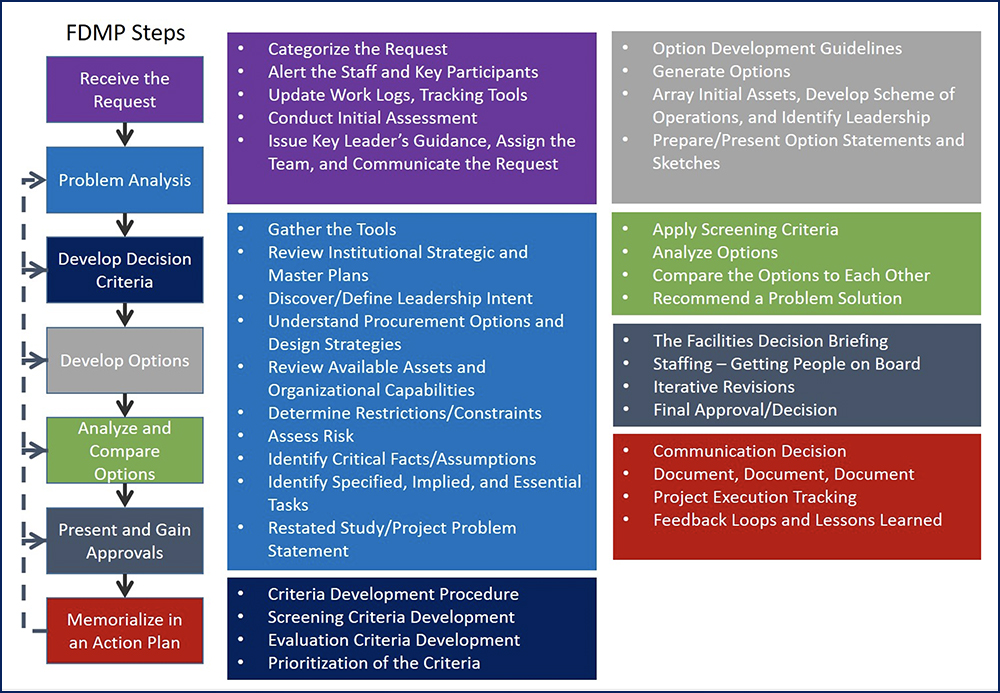
If you have been frequenting the pages of Facilities Manager magazine over the last decade, you might have seen a pattern or theme emerge: there’s a lot on our plate as facilities professionals to decide. Lander Medlin, APPA President & CEO, has been hammering home how much needs to be done and how we, as educational facilities experts, need to be at the forefront of our institution’s leadership challenges. APPA has been doing all it can to give us tools, training, credentialing programs, and much more to address the realities of the future. But, at our institutions, how do we decide what to do? How do we chart the right path? How do we ensure we have the best fighting chance to be the stewards that ensure we make tomorrow better than today? All great questions, but they all come down to how we make better, ideally superior, decisions.
As facilities managers and engineers, we are fundamentally confronted with two kinds of problems: 1) well-defined problems and 2) ill-defined problems. In the former case we have a catalog of guides, procedures, and reliable tools we can easily grasp in order to “get down to business” and solve them. We know well how to triage a waterline leak, or a hot/cold call, or a large spill of pasta on the floor at the cafeteria/dining facility. We often have a really well-developed rubric/system for such repeatable service calls. These are well-defined problems that have very few unknowns to address and even fewer unknowns in the solution options to apply. They can often be automated to the point of assigning a technician to go address the issue with a handbook of trouble-shooting techniques or actions. These kind of decisions are not the ones that keep people up at night or, at the individual decision point, are the things that we’ve been discussing over the last decade in regard to delivering facilities services better.
Weighing the Choices for Ill-Defined Problems
What is causing our challenges across educational facilities and infrastructure are the ill-defined problems. And most decisions in facilities organizations are of this type. These are problems where it’s hard to get at all of the variables in a reasonable timeframe/cost or have a range of potential solutions that require making various tradeoffs among numerous criteria we are trying to achieve. For instance, how do we weigh the choices on how we replace a boiler in a facility or execute a major capital project when first cost, total cost of ownership, climate goals, utility costs, LEED rating, and other factors are in the mix? Or how about the frequency or method of solid-waste pickup within a facility, when APPA level-of-service, overall appearance, enrollment considerations, labor availability, and so forth all have to be considered? Or what to do about campus roadways when traffic concerns, pedestrian safety, costs (short- and long-term), and bike-friendly university designations are on the line? All of these require more than a proverbial “easy button” to solve.
Sadly, as has been borne out in numerous studies and many of our experiences, too often these problems are resolved through an intuitive response. Depending on the size and type of the issue, the decision may be in the hands of a non-technical or non-facilities professional, such as the chief financial officer (CFO), the president/chancellor, or someone else with much less than the best information available or without good consultation with folks that will be directly impacted by the decision (both users and the implementers). Upper management has limited time and, too often, the perceived urgency and/or importance of addressing the problem at hand results in partially baked solutions that don’t rise to the real short- and long-term needs. I don’t know how many times I’ve worked with a shop service technician/tradesperson on something and we just had to shake our heads at what seems to have been the poor choices being made, often out of ignorance, that end up costing the institution for decades to come.
Part of our mandate, as facilities professionals, is to arrive at better decisions to the plethora of ill-defined problems that we address every day, week, month, and year-in and year-out at our institutions. Those better decisions still may not be optimal. Actually, the resulting solutions, if we are doing our jobs right, are almost always are sub-optimal in some way relating to one or more criteria we are trying to achieve. But we can minimize the downsides while maximizing the upsides as we determine and implement solutions to the problems we encounter. Our job is to pick the least worst among the options, work to make the implementation go as well as possible, and ameliorate the “badness” as much as we can while doing so. In order to be positioned to make better decisions, there are several things we need to do to ensure we meet the challenges ahead.
Adopting A Framework
Foremost, we need to adopt a framework for how we address these ill-defined problems. I have put forward just such a seven-step framework, called the Facilities Decision Making Process (FDMP, https://doi.org/10.1108/F-06-2020-0081). This repeatable, scalable, comprehensive, and robust procedural approach can be applied in any enterprise to make facilities and infrastructure decisions (see inset). This approach has already demonstrated success in both collegiate and military facilities contexts. The key thing is to adopt the FDMP and use it regularly, even if not requested by upper management, to move from intuitive decision making to being less error prone, abductive reasoning within a facilities context.
The FDMP depends on some important elements. These include:
- Clear set of institutional goals and objectives that can be articulated to form criteria (screening or evaluation) within the FDMP (Transforming Facilities to Achieve Student Success: https://www.appa.org/wp-content/uploads/2019/06/Final-2017-Thought-Leaders-FULL-Version.pdf).
- Readily available facilities information (not just data) that can be used as inputs into the process making available the breadth and depth of information systems at your disposal. (See chapter 11 of the APPA Operational Guidelines for Educational Facilities: Maintenance, third edition, and the facilities informatics website: https://www.appa.org/standards-codes/informatics-work-group/).
- Operational and leadership discipline to not truncate the process/revert to an intuitive as an easy way out when time/resources are perceived to be limited (The Landscape, Framework, and Strategies for Managing & Mitigating Risk: https://www.appa.org/wp-content/uploads/2019/06/Thought-Leaders-2018_FINAL.pdf).
- Culture of trust, collaboration, and consultation, not only within the facilities organization, but also the larger educational organization, which permits a free flow of information, transparency of process, and willingness to hear what may not want to be heard so as to avoid prejudicing results or brushing away the downsides that will have to be addressed (or at least acknowledged) in some manner (Innovation in an Age of Disruption: https://www.appa.org/wp-content/uploads/2019/07/Revised-Thought-Leaders-2019-7-29-19.pdf).
Each of these factors will exist at varying levels at any institution. The better the institution makes them, the better the resulting decisions to the problems we face. Regardless, implementation of the FDMP will help to get organizations to improve in all of these areas. Consequently, we will improve the quality and satisfaction with the decisions made in service to the overall mission of the institutions we serve as facilities professionals.
So then, in the face of the choppy seas of managing and engineering our facilities future, it’s time to make one critical decision: how are you going to decide? Are you going to continue to lash yourself to the poorly made raft of what too many institutions have fallen on to of using as their (lack of) decision making process? Or are you going to come aboard to use the FDMP as a mechanism for how to get at superior results? The choice, the decision, is yours; but time is of the essence in making it.

Steps of the FDMP with sub-step color-coded to match FDMP steps.
Erik Backus is director, construction engineering management at Clarkson University in Potsdam, NY, and can be reached at [email protected].
Perspective on the Profession
Provides opinion and commentary on aspects of education administration, funding, and campus facilities management. To contribute, contact [email protected].
See all Perspective on the Profession.


